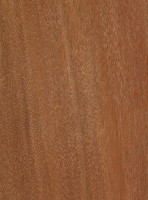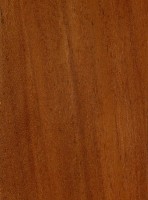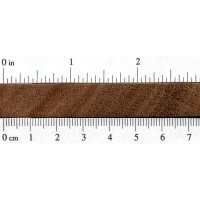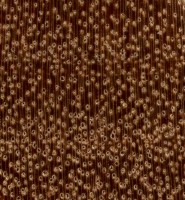 |
Common Name(s): Araracanga, Volador Scientific Name: Aspidosperma megalocarpon Distribution: Mexico, Central America, and northern South America Tree Size: 100-120 ft (30-37 m) tall, 3-4 ft (1-1.2m) trunk diameter Average Dried Weight: 59 lbs/ft3 (935 kg/m3) Specific Gravity (Basic, 12% MC): .75, .94 Janka Hardness: 2,450 lbf (10,900 N) Modulus of Rupture: 22,060 lbf/in2 (152.1 MPa) Elastic Modulus: 3,041,000 lbf/in2 (20.97 GPa) Crushing Strength: 12,830 lbf/in2 (88.5 MPa) Shrinkage: Radial: 5.8%, Tangential: 9.3%, Volumetric: 16.5%, T/R Ratio: 1.6 |
Color/Appearance: Heartwood ranges from golden yellow to reddish brown, sometimes with violet/pinkish streaks. Yellowish sapwood not always clearly demarcated from heartwood. Color tends to darken with age.
Grain/Texture: Grain is straight with a uniform medium texture.
Endgrain: Diffuse-porous; medium pores in no specific arrangement; exclusively solitary; growth rings indistinct; rays not visible without lens; parenchyma not visible.
Rot Resistance: Durability can vary based on growing location: rated anywhere from moderately durable to very durable regarding decay resistance, though susceptible to insect attack.
Workability: Overall easy to work, producing good results, though Araracanga has an above average blunting effect on cutters. Glues, turns, and finishes well.
Odor: No characteristic odor.
Allergies/Toxicity: Although severe reactions are quite uncommon, Araracanga has been reported to cause skin and respiratory irritation, as well as asthma-like symptoms. See the articles Wood Allergies and Toxicity and Wood Dust Safety for more information.
Pricing/Availability: This wood is serldom seen for sale in the United States. Prices should be in the mid-to-high range for an imported species.
Sustainability: This wood species is not listed in the CITES Appendices, but is reported by the IUCN as being near threatened. Technically it doesn’t meet the Red List criteria of a vulnerable or endangered species, but is close to qualifying and/or may qualify in the near future.
Common Uses: Furniture, general construction (within its natural range), flooring, boatbuilding, and turned objects.
Comments: Araracanga, sometimes called Volador, is a close relative of more popular Peroba Rosa. Araracanga is slightly heavier, stronger, and of a coarser texture than Peroba Rosa.
 |
 |
 |
 |


Hey, first of all I would like to thank you for this database! It has been of great help for me in the past. I am not sure whether “Araracanga” is A. megalocarpon. The shaft of A. megalocarpon is highly intertwined. In Panama its called “Canalu” for that reason. Here some pictures from a highly trusted source: https://biogeodb.stri.si.edu/herbarium/search/quick/?search_key=aspidosperma+megalocarpon Though there is a straight, red variant which is called A. spruceanum and yellow variant called A. desmanthum, which are called Alcaretto rojo y amarillo in Panama. They are one of the preferred woods used by villagers to construct huts on the… Read more »